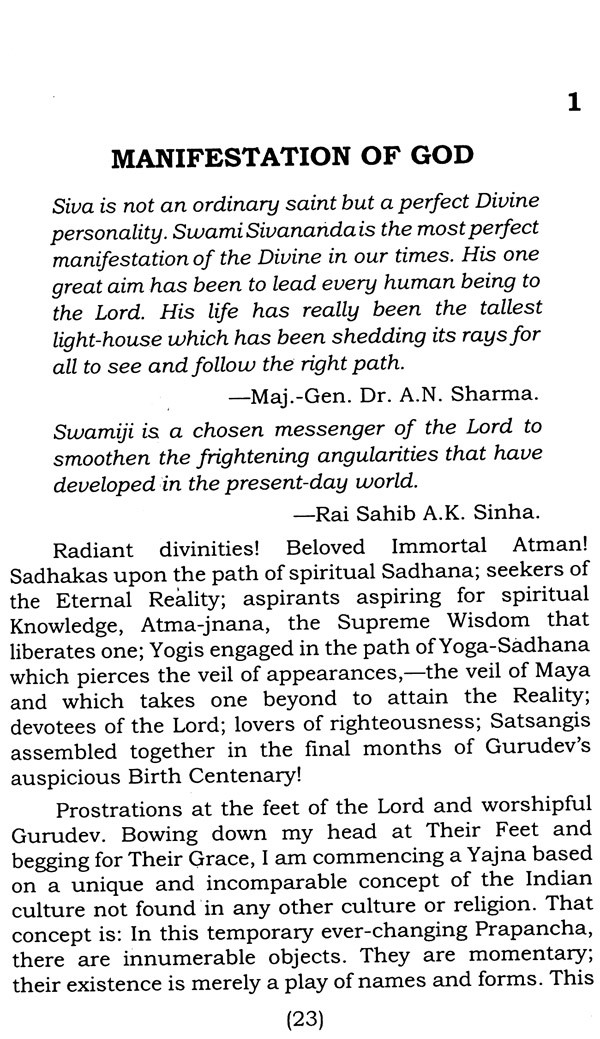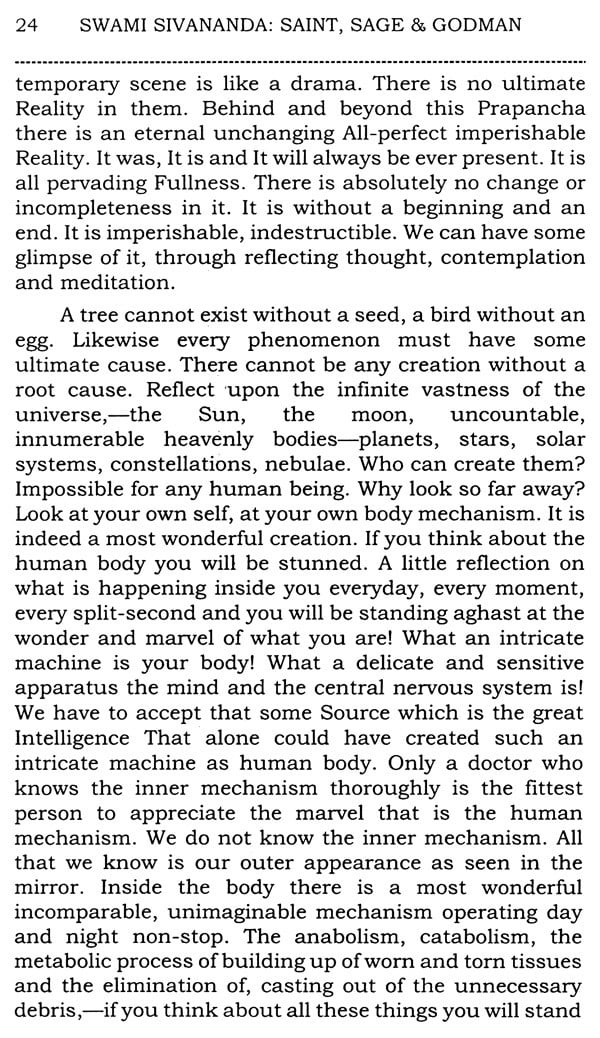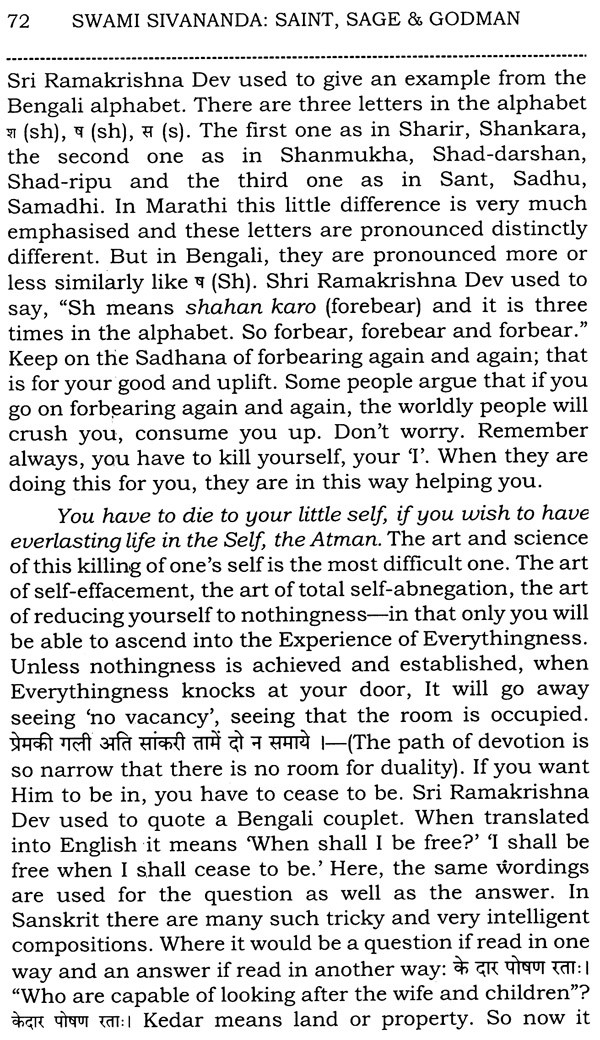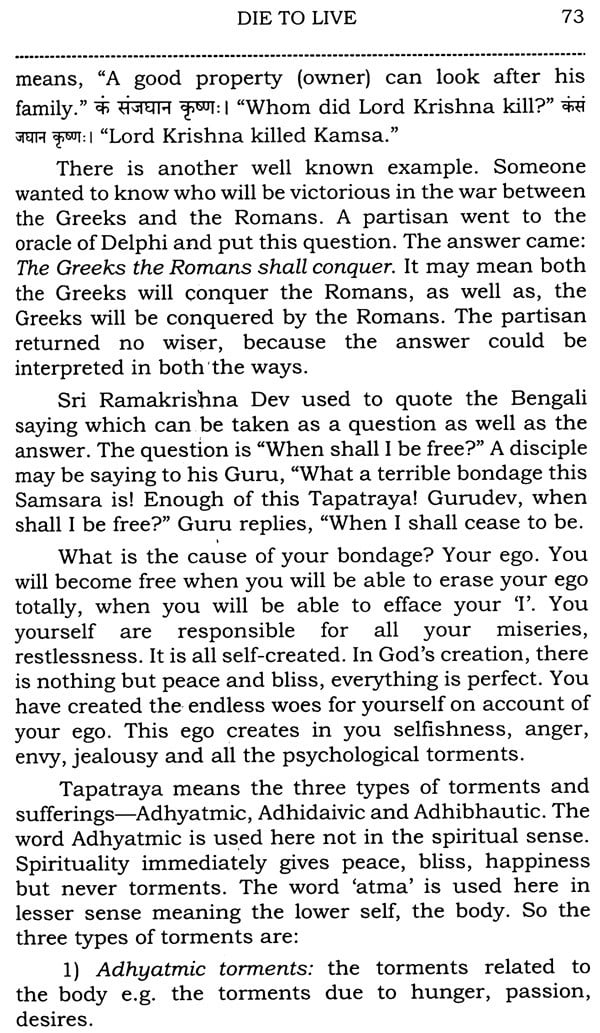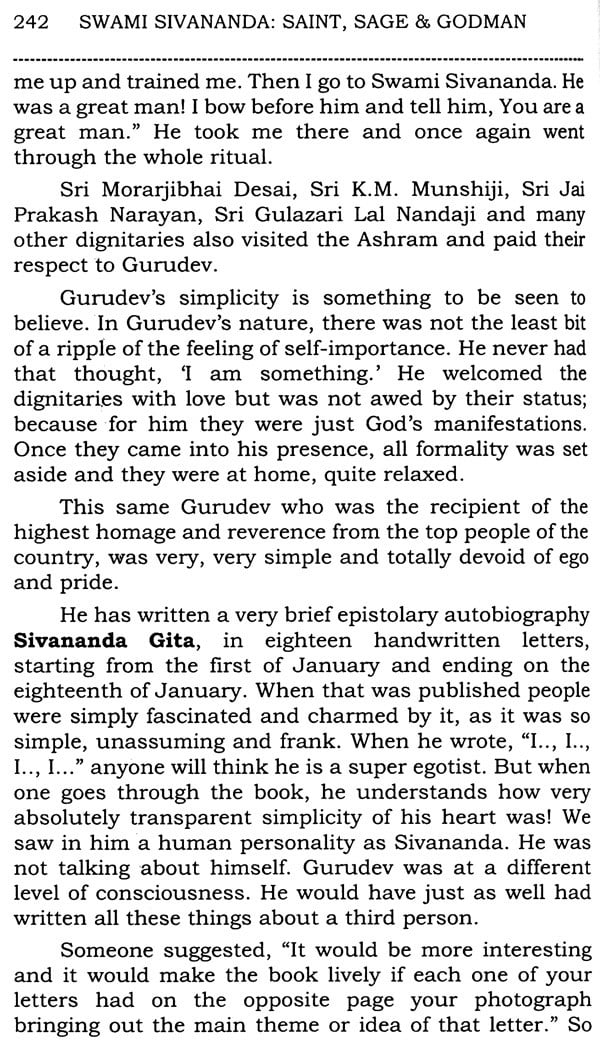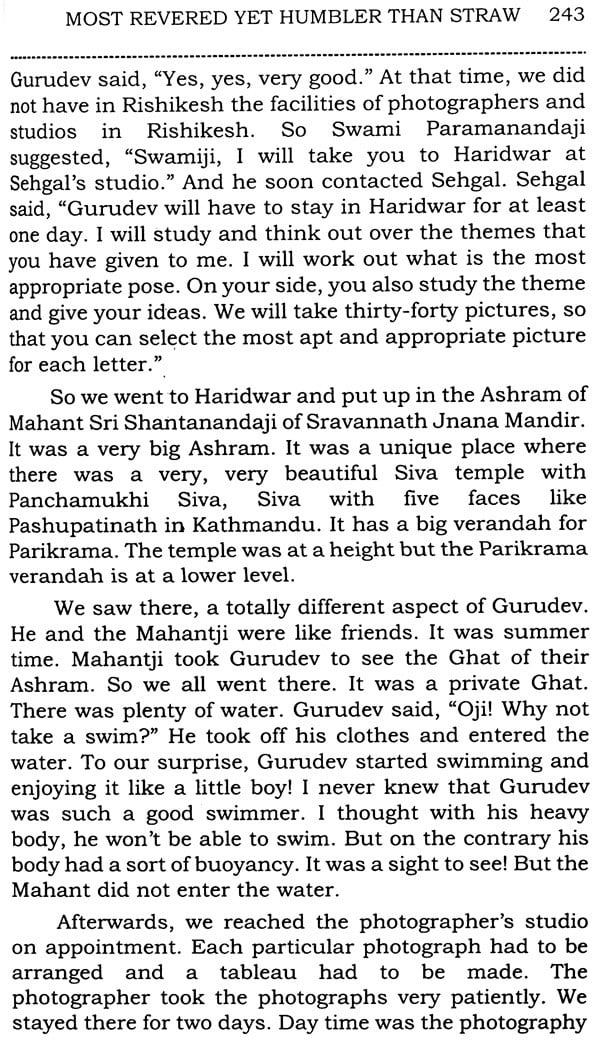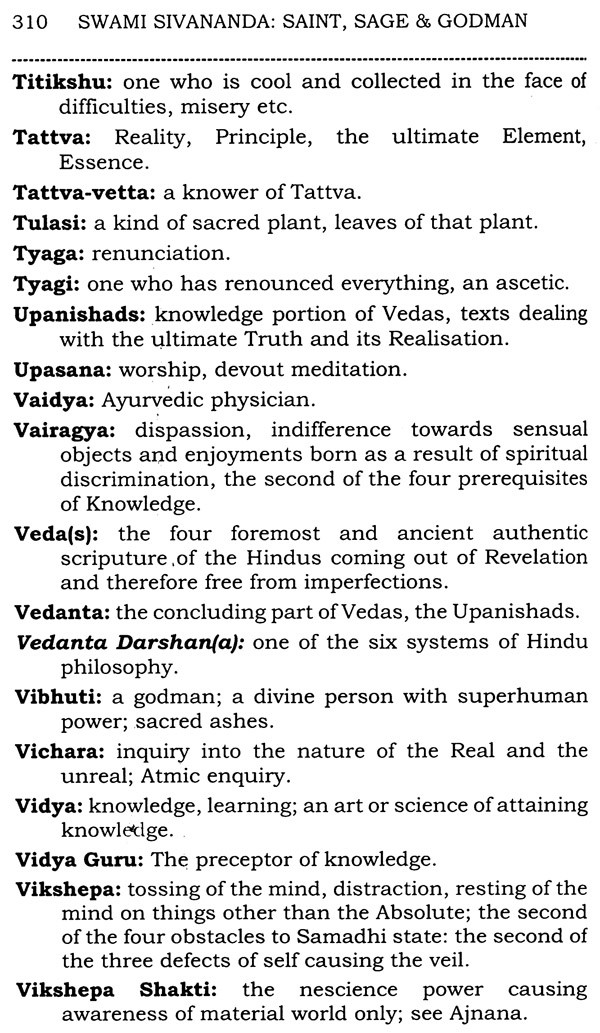
Swami Sivananda (Saint, Sage and Godman)
Book Specification
| Item Code: | IDL062 |
| Author: | Sri Swami Chidananda |
| Publisher: | THE DIVINE LIFE SOCIETY |
| Language: | English |
| Edition: | 2016 |
| ISBN: | 817052122x |
| Pages: | 336 |
| Cover: | Paperback |
| Other Details | 8.5" X 5.5" |
Book Description
Gurudev preached only those things which he himself had practised most diligently over a long period. So the best way to find answers to these basic questions is to study his life and personality. Those were the most blessed persons who had the good fortune of staying in the Sivananda Ashram as disciples during his lifetime. Sri Swami Chidanandaji Maharaj, President, The Divine Life Society, had that good fortune for two decades and is, therefore, the most appropriate authority to dilate upon these questions. In these talks, he has brought out the inherent salient teachings from Gurudev's life and known light on Gurudev's vision, his real message and his most important teachings. These talks were given in Gurudev's Samadhi Shrine from 26th July to 10th August, 1987.
The book will prove to be an invaluable treasure for all sincere seekers, Sadhaka and householders and inspire them to tread in righteous living and to strive for the goal of life, God-realisation.
Unfortunately we had neglected and forgotten our rich cultural heritage, invaluable legacy and basic values of life, and slipped into a dark are. With the coming of the western civilisation a wild goose chase after materialism began and some people even started condemning, degrading and ridiculing our own wisdom teachings. Towards the end of the nineteenth century a resurgence began with the advent of great saints like Sri Ramakrishna Dev Paramhamsa and his disciples Swami Vivekananda and others, Swami Rama Tirtha, Sri Ramana Maharshi, Swami Ramdas and others.
The most significant contribution in this resurgence and restoration of righteous living and spiritual values is of Gurudev Swami Sivanandaji. Sri Gurudev wrote more than three hundred books in English and a great many of them have been translated in almost all our country's vernacular languages and a number of foreign languages like French, German, Spanish, Italian, etc. Thus Gurudev's message of spiritual awakening reached countless thousands of homes throughout the length and breadth of the country and the world.
His language is simple and the teachings are direct. He explained the most subtle subjects of our scriptures in such a simple way that anyone can easily understand them even at first reading. He preached only those things which he himself had practised for a long time. His teachings are not empty words of bookish knowledge. They penetrate the heart of the reader and inspire the reader onto spiritual pursuits and sincere Sadhana. I am, therefore, never tried of speaking again and on Gurudev's ever inspiring wonderful teachings and his life of austerity, highest Sadhana and total inner detachment and dispassion.
So, when the Swami Sivananda Centenary Celebrations Central Committee asked me to speak on Gurudev's life and his teaching, I readily accepted it. There is another reason also. Gurudev has written so many books on all subjects related to Sadhana and there are numerous biographies on his life that a modern man many not able to read them all and get a clear direction as to what his real message is, on what he emphasised more, and what type of Sadhana he wanted his disciples to take up. Therefore I have tried to focus attention on those points which make Gurudev's vision clear and which are most relevant and useful to the Sadhana and to the householders. Gurudev's life and his spiritual practices are always a source of inspiration to all sincere Sadhakas. I have touched upon certain aspects and incidents of his life, which had some inherent salient teachings and left a lasting impact on us-the resident disciples.
May the divine grace of God and Gurudev's choicest blessings be upon all those who have contributed and helped in bringing out this book and upon all the readers. May you all follow Gurudev's teachings to attain Perfection and supreme Bliss in this very birth.
His ancestor, Maha-mahopadhyaya Sri Appayya Deekshitar was a very famous and unrivalled Sanskrit scholar and attained the highest spiritual state. In Tamil Nadu he is held in reverence next to Lord Siva only. His grandfather was a Zamindar in Pattamadai. His uncle Appayya Sivam was a great Sanskrit Scholar and has written many philosophical books in Sanskrit. His father, a Tahsildar in Ettaiyapuram estate, was a virtuous, pure soul a Siva-bhakta and a Jnani. He used to shed tears worshipping Lord Siva and used to utter Sivoham, Sivoham frequently.
In his boyhood itself he showed signs of renunciation and love for all, and the spirit of giving freely, of sharing without any restraint. He had the gift of divine vision even as a young boy. His father used to send him to bring flowers, Beal leaves and fruits for his daily worship. He often distributed the fruits to needy poor and would tell his father, he had already worshipped God in poor! Yogi Suddhananda Bharati, a boyhood friend of Gurudev Swami Sivanandaji, recalled how Kuppuswami as a little lad, one day ran out with his plate of food when heard a beggar's cry outside. He used to pity the poor and feed the hungry at the door, makes his father give a small coin to very beggar. Whenever he got sweetmeats from his mother, he distributed them liberally to his younger companions, poor, hungry and even to dogs, cats, cows, birds, himself not eating a bit though he loved sweets very much.
Kuppuswami studied at the Rajah's High School, Ettaiyapuram. He always topped the class and won the prizes every year. He was equally brilliant on the sportsfield as well. He used to practise fencing and gymnastics, getting up at 3 a.m. Though he was born in a very orthodox, highly respected Brahma family at a time when strong caste prejudices and rigid untouchability prevailed in India, he showed the uncommon gift of equal vision and boldness in taking fencing lesson from a untouchable, an he even prostrated him every time and treated him with respect as Guru.
After completing matriculation in 1903 he joined the S.P.G. College,, Tiruchchirappali. He had a sweet voice and wonderful memory and took part in debates and dramas and was a notable star of the college theatre, But he was forced to choose a profession course and joined the Medical school, Thanjavur. He was extremely industrious and never went home during the holidays and spent his time in the hospital trying to acquire more and more knowledge. He had a phenomenal memory and could retain whatever he read. He has said that even during his first year papers. He was first in all the subjects and was allowed free admission to operation theatre also.
Kuppuswami completed the medical course and earned the title M.B.C.M. The doctor started his medical practise in Tiruchi, while practising, he started in 1909 a medical journal Ambrosia, He observes:
"Ambrosia ran successfully for four years until I sailed for Malaya. It was a demi-quarto size, 32 pages each issue and beautifully got up. The material that its contents presented to the reader was attractive and highly useful to medical practitioners. A significant spiritual touch could be felt in its pages.
"Unlike other medical journals, the entire outlook was based on the teachings of the yore, Spirituality was ingrained in me even in my youth."
he went to Madras to join Dr. Haller's Pharmacy. Soon after his father's death, he left India to go Malaysia for better prospects.
here are his experience in Malaysia in his own words:
"I packed my things and did not forget to talks a good quantity of sweets which my mother lovingly prepared for me. I belonged to an orthodox family and was afraid to take non-vegetarian food on board the ship. In my youth I liked sweet preparations immensely. Throughout the voyage, I managed to live on the sweets and drank plenty of water. As I was not accustomed to continued consumption of sweets and fiery determination helped a great deal in moulding my life and spiritual character.
"Dr. Parsons took me to Mr. A.G. Robins manager of a rubber estate which had its own hospital. He asked me, 'Can you ménage a hospital all by yourself? "I replied, 'Yes, I can manage even three hospitals!' I was appointed at once!
"I served the estate hospital near Seremban for nearly seven years, after which I joined the Johore Medical Office Ltd. I learn the Malaya language and covered with the natives in their own tongue. I served the works of the estate nicely and endeared myself to them. I gained the esteem of the employer and the employer alike. I was always fond of service. One moment O would be in the hospital and the very next moment, in some poor patient's house to attend him and his family. Off and on, I would give my earnings to assist friends and patients. I even went to the extent of pawning some of my valuables.
"In addition to my own work. I would visit other hospitals to acquire special knowledge. There was not a single available English medical book at that time that I had not read and digested.
"Soon I became well-known in Seremban and Johore Bahru. The bank manager would oblige me at any time, even on holidays, by honouring my cheques. I became everybody's friend through my social disposition and service. I got rapid promotion and with that my salary and private practice increased by leaps and bounds.
"All this was not earned in a single day. It meant very hard work, unflagging tenacity, effort and indomitable faith in the principles of goodness and virtue and their practical application in my daily life.
"I never demanded any fee from my clients. I felt happy when they were free from disease and trouble. To serve people and share what I have is my born nature.
"I used to cheer up people with my wit and humour and elevate the sick with loving and encouraging words. The sick at once felt a new health, hope, vigour and vitality. Everywhere people declared that I had a special gift from God for the miraculous cures effected in the patients and acclaimed me as a very kind and sympathetic doctor with charming and majestic personality.
"In serious cases, I kept vigil at night in the company of the sick. I understood their feeling and endeavoured to relieve their sufferings."
Once a poor man drenched to the skin, came to Dr. kuppuswami at might. His wife was in birth pangs. The doctor went at once to her aid, and after attending her, stayed outside the hut in spite of heavy rain. Only after the safe delivery of the child did the doctor return home next morning.
The two extremes of his nature have also been noted by him:
"I had a great liking for high class dress, collection of curios and fancy articles of gold, silver and sandalwood. Sometimes, I would purchase various kinds of gold rings and necklaces and wear them all at the same time. When I entered shops I never spent time in selection. I gathered all that I saw. I never liked haggling and bargaining. I paid the bills without scrutiny.
"I was as pure as a crystal and did my daily worship, prayers, study of scriptures. I would conduct Nandana Charitam (Hari Katha) and sign Bhajans and Kirtans. Even in Malaya I practised Anahata Laya Yoga and Swara Sadhana.
In spite of extremely busy life, the doctor was very regular in his daily worship, prayers and Yogasanas, as well as study of sacred scriptures like the Gita, the Bhagavatam, the Ramayana, the Mahabharata and books of Sankaracharya, Swami Rama Tirth, Swami Vivekananda and the Imitation of Christ, the Bible and the literature of Theosophical Society. He always served Sadhu, Sannyasins and beggars. Once a Sadhu left behind on the doctor's table a much worn book, Jiva-Brahma Aikya Vedanta Rahasyam by Cuddapah Satchidananda Swami. The Vedantic book ignited dormant spirituality in the doctor in whom the process of Vichara and Viveka had already begun and brought Vairagya in him. He started reflecting more and more deeply. He observes:
"Is there not a higher mission I life than the daily round of official duties, eating and drinking? Is there no higher form of happiness than these transitory and illusory pleasures? How uncertain is life! How insecure is the existence on this earth-plane, with all kinds of diseases, anxieties, worries, fears and disappointments! The world of names and forms is ever changing. Time is fleeting. All hopes of happiness in this world terminate in path, despair and sorrow.
"Such were thoughts constantly rising in y mind. The doctor's profession provided me with ample evidence of the sufferings of this world. True, lasting happiness cannot be had merely in acquiring wealth. With the purification of heart through selfless service, I had a new vision. I was deeply convinced that there must be a place-a sweet home of pristine glory, purity and Divine splendour - where absolute security, prefect peace and lasting happiness can be had through Self-realisation.
"I frequently remembered the words of Srutis: 'The day on which one gets dispassion, that very day one should renounce the world.'
"So I gave up the life of ease, comfort and luxury and reached Indian in search of an ideal center for purposes of prayer, meditation, study and a higher form of service to the world."
As days passed, he became more and more convinced about the futility of worldly life and inner craving for higher life became stronger and stronger. At last the day dawned when the doctor gave up his very lucrative practice and all his belongings in a state of total renunciation and came to Indian I 1922, to live a life of a penniless Sadhu.
After some pilgrimage he reached Rishikesh in the beginning of the year 1942. After staying for some months in Ramnagar, he went to Swargashram and selected a sequestered Kutir for intense penance. On June 1, 1924 when he was sitting on the banks of holy Ganga, a venerable saint swami Vishwananda Saraswati was attracted by the spiritual aura of the young aspirant and gave him Sannyasa immediately. The Kailas Ashram Mahamandaleshwar Swami Vishnudevananda performed the ceremonies and gave him Vidhivat Sannyasa Deeksha, and the name Swami Sivananda Saraswati.
Swami Vishwananda had given some instructions and guidance about Sannyasa Dharma but never met his disciple again. The young seeker plunged himself in very intense Sadhana all by himself. His personality, Sadhana and approach to spiritual matters were all unique. He imitated none. He lived a life of extreme austerity and simplicity in the tradition of ancient Rishis of India. He dressed to clothe himself, ate to live and lived serve the humanity. He would go to Kshetra once a week only, bring the Rotis, dry them and ate after soaking in Ganga water. He used to do Japa sunrise. He often spent more than twelve hours in daily meditation.
With all his intense Tapas Sri Swamiji did not neglect selfless service. He fetched water and brought Bhiksha from Kshetra for old and sick Sadhus and cleaned their hunts. He gave medicines to the sick and even massaged their legs. He personally attended cholera and small-pox patients, when necessary, he kept vigil throughout the night by the side of ailing Sadhus. He once carried a sick Sadhu on his back to the hospital. From the money he received from his insurance policy, he started a charitable dispensary at Lakshman Jhula in 1927, to serve the Kedar-Badri Yatra pilgrims, Sadhus and poor. He saw God in every being and treated the sick with the sincerity of worshipping God.
Sri Swamiji was on one hand explaining the most intricate principles of Kevala Advaita Siddhanta (monism) in his lectures, on the other hand, he was doing Sankirtan in his sweet, melodious voice, full with love and used to shed tears or dance on the stage in moods of ecstasy, and earned the name of Sankirtan-Samrat.
After intense Tapas, severe austerity, deep study of scriptures, unparalleled selfless service of all the beings and long hours of daily meditation for ten long years of continuously, Swami Sivanandaji attained the supreme state of Nirvikapla Samadhi and the Sadhana emerged as a Siddha, the Sadhu as a saint the man as godman.
His burning desire to help the entire humanity and his spirit of sharing whatever he had, found yet another direction. He started sharing his spiritual experience through his writings from 1927 onwards. In the beginning he wrote articles but his enthusiasm of helping others took the form of a continuous flow of Jnana-Ganga of more than three hundred books. It was his this spirit which was responsible for sowing the seeds of the Divine Life Society in 1936.
Sri Swamiji came to the right bank of Ganga in 1934 and occupied and old dilapidated and abandoned shed which was used to shelter cows and donkeys. Though he was unassuming, totally devoid of doership and attachment, and spent most of his time in seclusion and Sadhana, the greatness of this soul attracted an incessant flow of seeking souls around him and the Divine Life Society and the Sivananda Ashram grew up rapidly and became known world over.
The inhuman killing of the World War II moved him and in order to release a continuous stream of peace-current in the whole world, he started the Akhanda Mahamantra Kirtan round the clock, non-stop chanting of Mahamantra was commenced from 3-12-1943 and is still going on continuously.
Swami Sivanandaji organized the All-World Religions Federation on 28-12-1945 and founded the All-World Sadhus Federation on 19-2-1947. to give a systematic spiritual training and guidance to the seekers, the Yoga Vedanta Forest Academy was established on 3-7-1948. in 1950 he undertook a lighting sixty-day All-India and Ceylon tour to deliver his divine message and for spiritual awakening of the people. The World-Parliament of Religions was held at the Sivananda Ashram from 3rd to 5th April, 1953.
Sri Swamiji believed in synthesis and moderation. He gave the concept of Yoga of Synthesis and advocated simultaneous practice of Bhaktiyoga, Karmayoga, Rajayoga and Jnanayoga and advised the seeker to emphasise on any one of these to suit his attitude and level. He greatly emphasised the need for sound health and good body and was strictly against torturing or neglecting the body. He explicitly said and reiterated again and again that the purpose of human birth, the goal of life is God-realisation.
The great soul entered Mahasamadhi on 14-9-1963.
| Publisher's Note | iii | |
| Preface | iv | |
| Swami Sivananda - A Brief Life-sketch | vi | |
| Sivananda Yogindra Stuti | xiv | |
| 1. | Manifestation of God | 3 |
| 2. | The Inner Revolution | 14 |
| 3. | Seeds of Vairagya | 25 |
| 4. | Practical Vedantin | 29 |
| 5. | Practised Before Preaching | 34 |
| 6. | Early Days of Ashram Life | 37 |
| 7. | Biographies of Gurudev | 42 |
| 8. | Sarvam Khalvidam Brahma | 45 |
| 9. | The Epistolary Autobiography | 50 |
| 10. | Die to Live | 55 |
| 11. | Absolutely Egoless | 71 |
| 12. | Self-control | 92 |
| 13. | Taught by Being | 108 |
| 14. | Inimitable Writings | 114 |
| 15. | Effacement of Ego | 125 |
| 16. | Serenity of Mind | 133 |
| 17. | Embodiment of Love, Kindness, Compassion | 138 |
| 18. | Inexplicable Ways | 154 |
| 19. | Selfless Service - The Foundation of Spiritual Ascent | 170 |
| 20. | Gurudev's Real Message | 188 |
| 21. | Divine Life | 214 |
| 22. | What Brought About a Change in Gurudev | 222 |
| 23. | Guru Without Gurudom | 232 |
| 24. | Most Revered Yet Humbler than Straw | 242 |
| 25. | Sadhana in Daily Life | 250 |
| 26. | Ideal Place for Sadhana | 268 |
| 27. | The Silent Teachings | 273 |
| 28. | Contemporary Saints | 178 |
| Appendix (i): Daily Routine | 289 | |
| Appendix (ii): Resolves for Quick Spiritual Progress | 292 | |
| Appendix (iii): Twenty Important Spiritual Instructions | 294 | |
| Appendix (iv): Sadhana Tattva | 297 | |
| Appendix (v): The Universal Prayer | 301 | |
| Appendix (vi): Some Memorable Dates in Swami Sivananda's Life and Mission | 302 | |
| Appendix (vii): Complete Works of Swami Sivananda | 304 | |
| Glossary | 310 |
